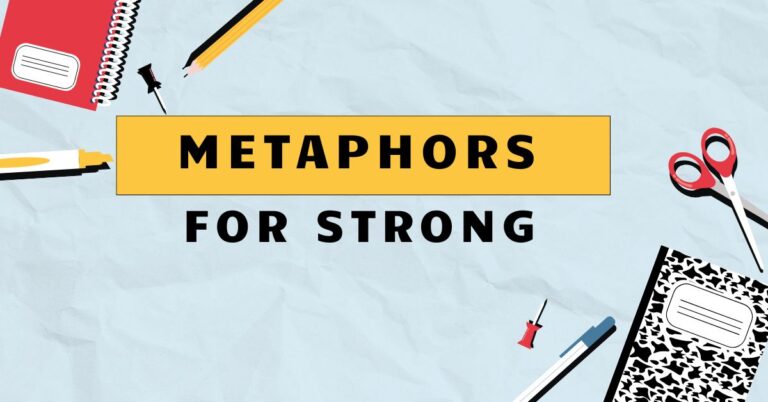37 Metaphors for Success: A Comprehensive Guide
Metaphors are powerful tools that enrich our language and understanding. When used to describe success, they offer unique perspectives and make abstract concepts more relatable.
Mastering the use of metaphors for success not only enhances your communication skills but also provides deeper insights into the nature of achievement. This guide is designed for students, professionals, and anyone seeking to improve their grasp of English grammar and elevate their expressive capabilities through metaphorical language.
This article will explore the definition, structure, types, and usage of metaphors related to success. We will delve into numerous examples, common mistakes, and practical exercises to solidify your understanding.
By the end of this guide, you will be equipped to identify, interpret, and effectively use metaphors for success in your writing and speech.
Table of Contents
- Introduction
- Definition of Metaphor
- Structural Breakdown of Success Metaphors
- Types of Success Metaphors
- Examples of Success Metaphors
- Usage Rules for Success Metaphors
- Common Mistakes with Success Metaphors
- Practice Exercises
- Advanced Topics in Success Metaphors
- Frequently Asked Questions (FAQ)
- Conclusion
Definition of Metaphor
A metaphor is a figure of speech that directly compares two unrelated things, asserting that one thing *is* another to highlight shared qualities or create a vivid image. Unlike similes, which use “like” or “as” to make comparisons, metaphors make a direct assertion, creating a stronger and often more insightful connection.
The power of a metaphor lies in its ability to transfer meaning and evoke emotions, making complex ideas more accessible and memorable.
In the context of success, metaphors provide a lens through which we can view achievements, challenges, and the overall journey. They can depict success as a climb, a race, a battle, or a blossoming flower, each image offering a unique perspective on the concept.
Classification of Metaphors
Metaphors can be broadly classified into several categories based on their structure and function:
- Standard Metaphors: These are common and widely understood metaphors (e.g., “time is money”).
- Novel Metaphors: These are original and creative metaphors that offer fresh perspectives (e.g., “success is a symphony of hard work and opportunity”).
- Dead Metaphors: These are metaphors that have become so common that they are no longer recognized as metaphors (e.g., “the heart of the matter”).
- Mixed Metaphors: These are combinations of two or more incompatible metaphors, often leading to confusion or humor (e.g., “We need to nip it in the bud and then put our shoulder to the wheel.”).
Function of Metaphors
Metaphors serve several important functions in language:
- Clarification: They make abstract concepts more concrete and understandable.
- Emphasis: They highlight specific qualities or aspects of a subject.
- Engagement: They create vivid imagery and evoke emotional responses.
- Persuasion: They can influence attitudes and beliefs by framing ideas in a particular way.
Contexts of Metaphor Use
Metaphors are used extensively in various contexts:
- Literature: To add depth, symbolism, and emotional resonance.
- Speeches: To engage audiences and make arguments more persuasive.
- Everyday Conversation: To express ideas in a more colorful and relatable way.
- Business Communication: To motivate teams, set goals, and explain strategies.
Structural Breakdown of Success Metaphors
Understanding the structure of a metaphor is crucial for effective use and interpretation. A typical metaphor consists of two main elements: the tenor and the vehicle.
- Tenor: The subject being described (in our case, success).
- Vehicle: The object or concept used to describe the tenor.
For example, in the metaphor “Success is a marathon,” the tenor is “success,” and the vehicle is “marathon.” The metaphor suggests that success, like a marathon, requires endurance, perseverance, and strategic pacing.
The effectiveness of a metaphor depends on the relationship between the tenor and the vehicle. A strong metaphor highlights relevant similarities and creates a meaningful connection between the two.
A weak metaphor, on the other hand, may be confusing or irrelevant.
Consider the metaphor “Success is a mountain to climb.” Here, the tenor (success) is being compared to the vehicle (mountain). The shared qualities might include difficulty, challenge, the need for planning and effort, and the rewarding view from the top.
A crucial part of understanding the structure is recognizing the implied meaning, or theground, of the metaphor. The ground refers to the shared characteristics or associations that make the comparison meaningful.
In the mountain metaphor, the ground includes the concepts of challenge, effort, and reward.
Types of Success Metaphors
Metaphors for success can be categorized based on the types of images and concepts they draw upon. Here are some common categories:
The Journey Metaphor
This is one of the most prevalent types, depicting success as a journey or path. It emphasizes the process, challenges, and progress involved in achieving goals.
Examples include:
- “Success is a long and winding road.”
- “The path to success is paved with hard work.”
- “He’s on the road to success.”
The Competition Metaphor
This type portrays success as a contest, race, or battle. It highlights the competitive nature of achievement and the need for strategy and resilience.
Examples include:
- “Success is a race against time.”
- “The business world is a battlefield.”
- “She fought her way to the top.”
The Growth Metaphor
This metaphor likens success to growth, development, and maturation. It emphasizes the organic and gradual nature of achievement.
Examples include:
- “Success is the fruit of hard labor.”
- “His career blossomed.”
- “She nurtured her business to success.”
The Building Metaphor
This type compares success to constructing a building or structure. It highlights the importance of planning, foundation, and incremental progress.
Examples include:
- “Success is built on a strong foundation of knowledge.”
- “He’s building a successful career.”
- “The company is a house of cards.” (negative connotation, implying instability)
The Light Metaphor
This metaphor uses light and darkness to represent success and failure, respectively. It emphasizes clarity, visibility, and enlightenment.
Examples include:
- “Success shone brightly on her.”
- “He emerged from the shadows of failure.”
- “The future of the company looks bright.”
Examples of Success Metaphors
The following tables provide extensive examples of success metaphors, categorized by type. Each example illustrates how metaphors can be used to describe different aspects of success.
Journey Metaphors
This table illustrates metaphors that utilize the concept of a journey to describe success.
| Metaphor | Explanation |
|---|---|
| Success is a marathon, not a sprint. | Success requires endurance and pacing, not just a burst of speed. |
| The road to success is always under construction. | Achieving success involves overcoming obstacles and continuous improvement. |
| Success is a pilgrimage. | Success is a meaningful journey requiring dedication and purpose. |
| His career path was a rollercoaster. | His career had many ups and downs. |
| She navigated the corporate ladder with skill. | She advanced through the ranks skillfully. |
| Success is a winding river. | Success follows an unpredictable course. |
| He’s charting a course to success. | He’s planning his path to success. |
| Success is a long hike up a steep mountain. | Success requires sustained effort and perseverance. |
| They’re on a fast track to success. | They’re quickly achieving success. |
| The journey to success is filled with potholes. | There are many challenges and setbacks on the path to success. |
| Success is like climbing a staircase, one step at a time. | Success is achieved through incremental progress. |
| The road to success isn’t always a smooth ride. | The path to success can be bumpy and challenging. |
| Success is a voyage of discovery. | Success involves learning and exploration. |
| He’s traveling down the path of achievement. | He’s making progress toward his goals. |
| Her career took a detour. | Her career took an unexpected turn. |
| Success is a never-ending expedition. | Success requires constant exploration and effort. |
| He’s mapping out his strategy for success. | He’s planning his approach to achieving success. |
| Success is an uphill battle. | Success requires great effort and determination. |
| The path to success is a marathon, not a sprint. | Success requires sustained effort and endurance, not just a quick burst of energy. |
| Success is a long and arduous journey. | Success requires time, effort, and perseverance. |
| She’s on the right track to success. | She’s making good progress towards her goals. |
| The road to success is paved with hard work and determination. | Achieving success requires dedication and effort. |
| Success is a voyage of discovery and self-improvement. | Success involves learning new things and growing as a person. |
| He’s navigating the twists and turns of his career. | He’s dealing with the challenges and changes in his professional life. |
| Success is a long and winding road with many obstacles along the way. | Achieving success is a complex and challenging process. |
| The journey to success is a continuous process of learning and growth. | Success is achieved through ongoing effort and self-improvement. |
| He’s embarking on a new chapter in his career. | He’s starting a new phase of his professional life. |
| Success is a path that requires courage, resilience, and perseverance. | Achieving success demands mental and emotional strength. |
Competition Metaphors
This table focuses on competitive metaphors that describe success as a contest or struggle.
| Metaphor | Explanation |
|---|---|
| Success is a boxing match; you have to fight for it. | Achieving success requires effort and determination. |
| The business world is a jungle. | The business environment is competitive and ruthless. |
| She’s a shark in the corporate world. | She’s aggressive and competitive in her career. |
| Success is a high-stakes poker game. | Success involves risk and strategic decision-making. |
| He’s battling his way to the top. | He’s overcoming obstacles to achieve success. |
| The market is a dog-eat-dog world. | The market is extremely competitive and unforgiving. |
| Success is a chess game; you need to think several moves ahead. | Achieving success requires strategic planning. |
| She’s a formidable competitor. | She’s a strong and challenging opponent. |
| Success is a race against time and competitors. | Achieving success requires speed and outperforming others. |
| He’s locked in a fierce battle for market share. | He’s engaged in intense competition for a larger portion of the market. |
| Success is a constant struggle against adversity. | Achieving success requires overcoming challenges. |
| She’s a warrior in the boardroom. | She’s assertive and strategic in business meetings. |
| Success is a game of survival of the fittest. | Achieving success requires adaptability and resilience. |
| He’s fighting an uphill battle for recognition. | He’s facing significant challenges in gaining recognition. |
| The business world is a battlefield. | The business environment is highly competitive and demanding. |
| Success is a contest of wills and determination. | Achieving success requires strong will and perseverance. |
| She’s a force to be reckoned with in her industry. | She’s a powerful and influential figure in her field. |
| Success is a battle against complacency and mediocrity. | Achieving success requires constant effort and improvement. |
| He’s waging a war against inefficiency and waste. | He’s aggressively working to eliminate inefficiency and waste. |
| Success is a game of strategy and tactics. | Achieving success requires careful planning and execution. |
| She’s a strategic player in the market. | She’s a skilled and calculated participant in the market. |
| Success is a competition where only the best survive. | Achieving success requires excellence and resilience. |
| He’s competing against the odds. | He’s facing significant challenges in his pursuit of success. |
| The business world is a competitive arena. | The business environment is highly competitive and demanding. |
| Success is a continuous battle for market dominance. | Achieving success requires ongoing effort to maintain a leading position. |
| She’s a relentless competitor in her field. | She’s determined and persistent in her pursuit of success. |
| Success is a challenge that requires strength, skill, and determination. | Achieving success demands physical and mental fortitude. |
Growth Metaphors
This table presents metaphors that use the concept of growth to symbolize success.
| Metaphor | Explanation |
|---|---|
| Success is the fruit of hard work and dedication. | Success is the result of diligent effort. |
| His career blossomed after years of hard work. | His career flourished and became successful. |
| She cultivated her business from the ground up. | She carefully developed her business from its early stages. |
| Success is like a seed that needs nurturing. | Achieving success requires care and attention. |
| He’s reaping the rewards of his labor. | He’s enjoying the benefits of his hard work. |
| Her ideas sprouted and grew into a successful company. | Her ideas developed and resulted in a thriving business. |
| Success is like a tree that grows stronger over time. | Achieving success requires patience and perseverance. |
| He’s harvesting the fruits of his efforts. | He’s enjoying the results of his hard work. |
| Her career has taken root and is flourishing. | Her career has become stable and successful. |
| Success is like a garden that needs constant tending. | Achieving success requires ongoing effort and maintenance. |
| He’s nurturing his talent to reach its full potential. | He’s developing his skills to achieve great success. |
| Her business has blossomed into a thriving enterprise. | Her business has grown and become very successful. |
| Success is like a plant that needs water and sunlight to grow. | Achieving success requires essential resources and support. |
| He’s sowing the seeds of future success. | He’s taking actions now that will lead to success in the future. |
| Her career has matured into a position of leadership. | Her career has developed and she has achieved a leadership role. |
| Success is like a flower that blooms in the right conditions. | Achieving success requires favorable circumstances and opportunities. |
| He’s cultivating relationships to foster his career growth. | He’s building connections to advance his professional development. |
| Her business has grown from a small startup to a major corporation. | Her business has expanded and become very successful. |
| Success is like a tree that bears fruit over time. | Achieving success requires patience and long-term investment. |
| He’s planting the seeds of innovation. | He’s introducing new ideas that will lead to future success. |
| Her career has blossomed into a rewarding and fulfilling journey. | Her career has flourished and brought her satisfaction and success. |
| Success is like a garden that requires constant care and attention. | Achieving success demands ongoing effort and maintenance. |
| He’s nurturing his skills to reach his full potential. | He’s developing his abilities to achieve great success. |
| Her business has grown from a humble start to a thriving enterprise. | Her business has expanded and become very successful despite modest beginnings. |
| Success is like a tree that provides shade and shelter to others. | Achieving success can benefit and support those around you. |
| He’s sowing the seeds of collaboration and teamwork. | He’s encouraging cooperation to achieve collective success. |
| Her career has matured into a position of influence and impact. | Her career has developed and she has attained a role of significant influence. |
Usage Rules for Success Metaphors
Using metaphors effectively requires adherence to certain rules:
- Clarity: Ensure the metaphor is clear and understandable to your audience. Avoid obscure or overly complex comparisons.
- Relevance: The vehicle should have a clear and logical connection to the tenor. The shared qualities should be apparent.
- Consistency: Avoid mixing metaphors within the same sentence or paragraph. Mixed metaphors can create confusion and undermine your message.
- Originality: While standard metaphors are acceptable, strive for originality to make your writing more engaging and memorable.
- Appropriateness: Consider the context and audience when choosing a metaphor. Some metaphors may be inappropriate in formal or professional settings.
For example, instead of saying “He jumped through hoops and climbed the corporate ladder,” which is a mixed metaphor, you could say “He climbed the corporate ladder with determination” or “He navigated the corporate maze with skill.”
Common Mistakes with Success Metaphors
Several common mistakes can undermine the effectiveness of metaphors:
- Mixed Metaphors: Combining incompatible images (e.g., “We need to nip it in the bud and put our shoulder to the wheel.”).
- Clichéd Metaphors: Using overused and unoriginal metaphors (e.g., “success is a journey”). While acceptable, they lack impact.
- Unclear Metaphors: Using metaphors that are difficult to understand or interpret.
- Inappropriate Metaphors: Using metaphors that are unsuitable for the context or audience.
Here’s a table illustrating common mistakes and their corrections:
| Incorrect | Correct | Explanation |
|---|---|---|
| He’s burning the candle at both ends and hitting the ground running. | He’s working tirelessly to achieve his goals. | Mixed metaphors create confusion. |
| Success is a journey. | Success is a challenging expedition requiring careful planning and unwavering perseverance. | Clichéd metaphors lack impact; be more specific. |
| Her strategy was a black hole. | Her strategy was ineffective and led to significant losses. | Unclear metaphors need explanation. |
| The CEO is a pitbull. | The CEO is an aggressive and determined leader. | Inappropriate metaphors can be offensive. |
Practice Exercises
Test your understanding of success metaphors with the following exercises:
Exercise 1: Identifying Metaphors
Identify the metaphors in the following sentences:
- Success is a tapestry woven with hard work and dedication.
- The path to success is paved with obstacles.
- Her career skyrocketed after the promotion.
- He’s building an empire from scratch.
- Success shone brightly on their endeavors.
- The market is a shark tank.
- His ideas are the seeds of future success.
- Success is a marathon, not a sprint.
- She navigated the corporate jungle with skill.
- Their company is a rising star in the industry.
Answer Key:
- Success is a tapestry
- The path to success is paved
- Her career skyrocketed
- He’s building an empire
- Success shone brightly
- The market is a shark tank
- His ideas are the seeds
- Success is a marathon
- Navigated the corporate jungle
- A rising star
Exercise 2: Completing Metaphors
Complete the following metaphors related to success:
- Success is like a ____ that needs nurturing.
- The road to success is a ____.
- His ambition is a ____ that burns brightly.
- Success is a ____ that requires careful planning.
- She’s a ____ in the corporate world.
- Success is a ____ against complacency.
- His career is a ____ climbing upwards.
- Success is a ____ of hard work and perseverance.
- The business world is a ____.
- Success is a ____ to be conquered.
Answer Key (Possible Answers):
- plant
- climb
- fire
- blueprint
- lion
- battle
- rocket
- result
- battlefield
- mountain
Exercise 3: Correcting Mixed Metaphors
Rewrite the following sentences to correct the mixed metaphors:
- He’s burning the midnight oil and sailing into uncharted waters.
- We need to nip it in the bud and hit the ground running.
- She’s climbing the ladder of success and swimming against the tide.
- He’s building bridges and putting all his eggs in one basket.
- They’re planting seeds and jumping through hoops.
- Success is a marathon and a sprint.
- He’s sharpening his axe and building a foundation.
- She’s a rising star and a shark in the water.
- Success is a journey and a battle.
- They’re navigating the waters and climbing mountains.
Answer Key (Possible Answers):
- He’s working late into the night to achieve his goals.
- We need to address the problem immediately and start working on it with great energy.
- She’s working hard to advance her career.
- He’s taking a significant risk by focusing on one opportunity.
- They’re investing in the future by working towards their goals.
- Success requires both endurance and bursts of speed.
- He’s preparing himself and laying the groundwork for future success.
- She’s a talented and ambitious individual.
- Success requires both perseverance and strategic action.
- They’re overcoming challenges to achieve their goals.
Advanced Topics in Success Metaphors
For advanced learners, consider exploring the following topics:
- Conceptual Metaphor Theory: This theory explores how metaphors shape our understanding of abstract concepts.
- Metaphorical Framing: This involves using metaphors to influence how people perceive and interpret events or issues.
- Cross-Cultural Metaphors: Understanding how metaphors vary across different cultures and languages.
- The Role of Metaphors in Leadership: How leaders use metaphors to inspire and motivate their teams.
Understanding these advanced topics can provide a deeper appreciation for the power and complexity of metaphorical language.
Frequently Asked Questions (FAQ)
- What is the difference between a metaphor and a simile?
A metaphor directly compares two unlike things by stating that one *is* the other (e.g., “Success is a marathon”). A simile compares two unlike things using “like” or “as” (e.g., “Success is like a marathon”). Metaphors are generally considered stronger and more direct.
- Why are metaphors important in language?
Metaphors enhance understanding, create vivid imagery, engage audiences, and make abstract concepts more relatable. They add depth and nuance to communication.
- How can I avoid using clichéd metaphors?
Strive for originality by thinking creatively and considering the specific context. Use more descriptive language and look for unique connections between the tenor and vehicle.
- What is a mixed metaphor, and why should I avoid it?
A mixed metaphor combines two or more incompatible metaphors, leading to confusion and undermining your message (e.g., “We need to nip it in the bud and put our shoulder to the wheel.”). It’s best to keep metaphors consistent.
- How can I improve my use of metaphors?
Practice identifying and analyzing metaphors in literature and everyday speech. Experiment with creating your own metaphors and seek feedback on their clarity and effectiveness.
- Are metaphors only used in writing?
No, metaphors are used extensively in both writing and speech. They are a fundamental part of human communication and thought.
- Can a metaphor be too complex?
Yes, a metaphor can be too complex if it is difficult to understand or requires too much interpretation. The best metaphors are clear and accessible to the intended audience.
- How do cultural differences affect the interpretation of metaphors?
Metaphors can be culturally specific, meaning their interpretation can vary across different cultures. Understanding these differences is crucial for effective cross-cultural communication.
- What role do metaphors play in motivation and leadership?
Metaphors can inspire and motivate teams by framing goals and challenges in a relatable and engaging way. Leaders often use metaphors to communicate vision and values.
- How can I use metaphors to make my presentations more engaging?
Incorporate relevant and vivid metaphors to capture your audience’s attention and make your points more memorable. Use visual aids to enhance the impact of your metaphors.
Conclusion
Metaphors are indispensable tools for describing and understanding success. By grasping their structure, types, and usage rules, you can significantly enhance your communication skills and gain deeper insights into the nature of achievement.
This guide has provided a comprehensive overview of success metaphors, equipping you with the knowledge and practice to use them effectively in your writing and speech.
Remember to practice identifying and creating metaphors, and always strive for clarity, relevance, and originality. As you continue to explore the world of metaphorical language, you’ll discover new and creative ways to express your ideas and connect with your audience.
Embrace the power of metaphors to elevate your communication and inspire others on their own journeys to success.







